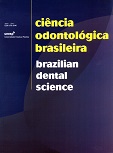Comportamento muscular durante diferentes práticas odontológicas
DOI:
https://doi.org/10.14295/bds.2008.v11i2.465Abstract
As Lesões por Esforços Repetitivos (LER) e Distúrbios Osteomusculares Relacionados ao Trabalho (DORT), são a segunda causa de afastamento do trabalho no Brasil. Aproximadamente 60% dos cirurgiões-dentistas apresentamalgum tipo de dor músculo-esquelética no ambiente de trabalho. O pescoço, costas, ombros e membros superiores se apresentam como os sítios de dor mais freqüentes, devido às exigências da alta precisão, posição estática e sustentada, limitado espaço de movimentação e pela contração isométrica criada pelo movimento executado. O presente estudo teve como objetivo investigar o comportamento eletromiográfico e o ponto de fadiga referida dos músculos deltóide (porção medial) e trapézio (porções descendente e transversa) bilateralmente. Foram avaliadas quarenta voluntárias, estudantes de Odontologia com média de idade de 21 anos, na posição de trabalho, divididas por especialidades clínicas em quatro grupos: 1 - periodontia, 2 - cirurgia, 3 - clínica geral e 4 - não cirurgiões-dentistas. Os músculos mais ativos foram as porções transversas dos trapézios, em seguida deltóides e porções descendentes dos trapézios e os mais fatigáveis foram os deltóides, em seqüência os trapézios, porções transversas e descendentes. Os músculos do antímero direito apresentaram-se mais ativos que os do esquerdo. O grupo 3 apresentou maior atividade eletromiográfica enquanto que o grupo 1 mostrou ser menos ativo. O grupo 4 apresentou ser mais vulnerável à fadiga muscular enquanto que o grupo 2 mostrou ser mais resistente. Concluímos que o trabalho odontológico executado por longos períodos diários leva os músculos da cintura escapular e cervicais à fadiga e dores musculares, independente da especialidade clínica realizada.
Downloads
Downloads
Published
How to Cite
Issue
Section
License
Brazilian Dental Science uses the Creative Commons (CC-BY 4.0) license, thus preserving the integrity of articles in an open access environment. The journal allows the author to retain publishing rights without restrictions.
=================




























